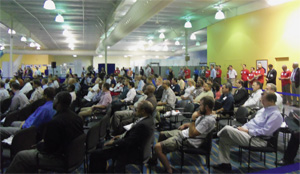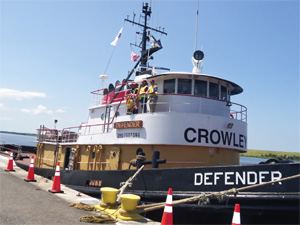With a shortage of qualified mariners due to the boom in U.S. energy production, the maritime industry is helping former military personnel transition to fill empty civilian sea billets.
A consortium of industry leaders, including the American Maritime Partnership, Transportation Institute, Crowley Maritime and the U.S. Maritime Administration (MarAd), has conducted three informational sessions targeting active-duty personnel and veterans.
The goal of the Military to Maritime program is to help ease the transition from military life to the civilian maritime world, said Mike Roberts, senior vice president and general counsel for Crowley Maritime.
“The idea was to provide a forum for information to active-service military and separated veterans about the process,” Roberts said.
The group of backers and exhibitors, most of them associated with the American Maritime Partnership, the trade group for the U.S.-flag fleet, organized events in Seattle, San Juan, Puerto Rico, and Jacksonville, Fla.
At San Juan and Jacksonville, Crowley docked a tug for tours to give military personnel a chance to see a civilian vessel and talk to the crew, some of whom had already made the transition from the military.
Growth in the energy sector has left the domestic near-shore fleet in the rare position of having more openings than mariners to fill them.
“I’ve been in the industry for over 20 years and this is the first time we’ve had a real need in the industry to recruit like this,” Roberts said.
Roberts said the organizers are considering adding similar events in cities where there are sea service military personnel.
 |
|
Hundreds of job-seekers learn about employment opportunities in the commercial maritime industry. |
|
American Maritime Partnership |
MarAd has offered its support in helping veterans transition to civilian maritime careers.
“Many of our veterans have skills and experience that can be major assets to our nation’s transportation network,” said Kirsten Allen, a MarAd spokeswoman. “Knowing this, we will continue working to address licensing challenges and support the interests of federal agencies to promote civilian jobs for those now serving our military.”
The educational forums are needed because the armed forces vary in their support of sea service members who want to earn civilian credentials while still in the service. Ironically, the U.S. Army’s record for preparing soldiers for work after the military was much better than the Coast Guard’s or Navy’s, Roberts said.
Despite years of training, sea service personnel from the Navy and Coast Guard usually did not qualify for civilian maritime credentials, said Rich Berkowitz, director of Pacific Coast operations for the Transportation Institute.
“You have people with many years of sea time leaving the military and they don’t get even the barest credentials, so when they separate they end up coming into the industry as ordinary seamen or wipers,” Berkowitz said. “And that situation doesn’t meet anyone’s needs, not the individuals nor the Department of Defense nor the U.S. maritime industry.”
The Army ensures its training classes at Fort Eustis, Va., the home of the Army Transportation Corps, are STCW-certified.
Berkowitz said the industry is working to expand recency requirements from five years to seven years and to give the Coast Guard and Navy “the impetus to look at full credentialing for the training that sea service members have received in their branch of the service.”
The Veteran Skills to Jobs Act of 2012 directs federal agencies to treat military training as sufficient for federal licenses, but it’s not clear how the Coast Guard will implement this law regarding marine certifications and licensure, Berkowitz said. Even getting a letter from the Veterans Administration certifying sea service time can take a year or more.
In some cases, achieving civilian certification after military service would require minimal additional work, such as basic safety training.
Berkowitz noted the goal of the effort is not to raid the military services, but to give separating members a career path into an industry that needs experienced personnel. It would put more ex-soldiers and sailors on board U.S.-flag vessels used by the Department of Defense, which comprise a large portion of the bluewater fleet.
“We have these forums to get vets to understand what the industry is looking for and what they need to do before they separate from the service or after they separate,” Berkowitz said. “Then we’re trying to get the Coast Guard to be more open-minded about how they interpret the STCW with respect to certification and training.”

